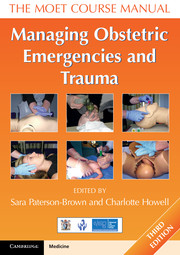Book contents
- Frontmatter
- Dedication
- Contents
- Working Group
- About the authors
- Acknowledgements
- Abbreviations
- Section 1 Introduction
- Section 2 Recognition
- Section 3 Resuscitation
- Section 4 Trauma
- 13 Introduction to trauma
- 14 Domestic abuse
- 15 Thoracic emergencies
- 16 Abdominal trauma in pregnancy
- 17 The unconscious patient
- 18 Spine and spinal cord injuries
- 19 Musculoskeletal trauma
- 20 Burns
- Section 5 Other medical and surgical emergencies
- Section 6 Obstetric emergencies
- Section 7 Triage and transfer
- Section 8 Human issues
- Index
18 - Spine and spinal cord injuries
- Frontmatter
- Dedication
- Contents
- Working Group
- About the authors
- Acknowledgements
- Abbreviations
- Section 1 Introduction
- Section 2 Recognition
- Section 3 Resuscitation
- Section 4 Trauma
- 13 Introduction to trauma
- 14 Domestic abuse
- 15 Thoracic emergencies
- 16 Abdominal trauma in pregnancy
- 17 The unconscious patient
- 18 Spine and spinal cord injuries
- 19 Musculoskeletal trauma
- 20 Burns
- Section 5 Other medical and surgical emergencies
- Section 6 Obstetric emergencies
- Section 7 Triage and transfer
- Section 8 Human issues
- Index
Summary
Objectives
On successfully completing this topic, you will be able to:
recognise circumstances in which spinal trauma is likely to occur
understand the importance and techniques of spinal immobilisation
identify and evaluate spinal trauma.
Introduction
In the context of this chapter, spinal injuries refer to injuries to the bony spinal column, the spinal cord or both. There can be an injury to the bony spine without injury to the spinal cord, but there is significant risk of cord injury in these circumstances.
Failure to immobilise a patient with a spinal injury can cause or exacerbate neurological damage. Failure to immobilise a patient with an injury to the bony spine (without cord injury at that stage) can cause avoidable injury to the spinal cord. Evaluation of the spine and exclusion of spinal injuries can be safely deferred, as long as the patient's spine is protected.
A spinal injury should always be suspected:
• in falls from a height (however it is possible to injure the spine in a fall from a standing position, e.g. fall due to a convulsion)
• in vehicle collisions, even at low speed
• when pedestrians have been hit by a vehicle
• where persons have been thrown
• in sports field injuries, e.g. rugby
• in a person with multiple injuries
• in a person with injury above the clavicle (including the unconscious patient – 15% of unconscious patients have some form of neck injury)
• in the conscious patient complaining of neck pain and sensory and/or motor symptoms
• in drowning victims.
- Type
- Chapter
- Information
- Managing Obstetric Emergencies and TraumaThe MOET Course Manual, pp. 201 - 212Publisher: Cambridge University PressPrint publication year: 2014
- 1
- Cited by

